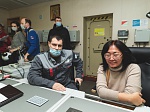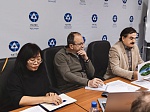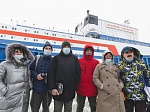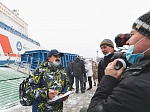12.10.2021
COMMUNICATIONS DEPARTMENT OF ROSENERGOATOM
The first public ecological expedition visited the northernmost FNHPP in the world
The first public expedition visited the town of Pevek of the Chukotka Autonomous Okrug and the northernmost of the nuclear power plants - the floating nuclear heat and power plant (FNHPP, a project of the State Atomic Energy Corporation Rosatom).
Among the main tasks before the participants were the collection and analysis of data on the state of the environmental, radiation, and safety of the floating nuclear power plant, as well as expert assessment and transfer of all the data obtained to the wide audience.
Environmentalists took measurements both at the floating nuclear thermal power plant and in the area of its location - Pevek, Chukotka Autonomous Okrug. The measurement results demonstrated that the background radiation in the area of the floating nuclear power plant and in Pevek is completely formed by natural sources: natural radioactive nuclides and cosmic radiation. Thus, the average values of the dose rate at the FNPP industrial site and in the town of Pevek do not exceed 0.12 μSv / h.
The head of the expedition, leading researcher at the Institute of Industrial Ecology of the Ural Branch of the Russian Academy of Sciences, Alexei Yekidin: “During the expedition, more than 20 measurements were taken at the FNHPP industrial site, as well as in the adjacent territory and in the town of Pevek itself, while no artificial radioactive nuclides were found at the surveyed sites... So it was concluded that the operation of the floating nuclear power plant does not make any negative contribution to the change in the radioecological situation in the region. "
Alan Khasiev, chairman of the coordinating council of the Oka IPEM (Interregional Public ecology movement): “Our program has been operating since 2010. During this time, in the monitoring mode, 44 full-scale environmental expeditions were performed to most of the operating, as well as those under construction, nuclear power plants of Russian design both in Russia and abroad, including at the Paks NPP and the Belarusian NPP. The ecological expedition to the floating nuclear power plant and in Pevek has become the next stage of this program."
Larisa Kosyuk, a member of the Russian ecological “Greens” party, biologist: “In the terms of the carbon regulation introduced by the EU, the FNHPP project can serve as an example of the introduction of green technologies in the energy sector. Such power plants will be especially useful in the regions of the Far North and the Far East, where there are no hydrological resources, and the delivery of fuel - coal and oil products - is expensive. According to the International Energy Agency, nuclear energy is the second largest source of energy in the world, accounting for 10% of the world's electricity generation. ”
The deputy director of the FNHPP branch Kirill Toropov told the expedition participants what changed in the town after the arrival of the FNHPP: “With its arrival, the FNHPP has not only become an additional source of energy: a new chapter has been opened in the energy sector of the region and the whole country in the development of energy technologies based on low-power nuclear power plants. Since its commissioning, the FNPP has already established itself as a reliable innovative source of thermal and electric energy, of particular note is its positive contribution to improving the environmental situation, both in Pevek itself - this is a 30% reduction in ash emissions
from the Chaunskaya CHPP, and in the water area of the town - this is the restoration of flora and fauna in the Chaun Bay, the return of seals and other species of sea animals”.
In his turn, the head of the Pevek town district Ivan Leyushkin pointed out the importance of the expedition for informing the public and residents of the region about the safety of nuclear power generation, and also spoke about the importance of the nuclear heat and power plant for the development of the territory: 107 million rubles. This cooperation will continue in the future - in September of this year, a cooperation agreement was signed between the governor of the Chukotka Autonomous Okrug Roman Kopin and the Director General of Rosatom Alexei Likhachev”.
Since its commissioning, the FNHPP has been conducting continuous industrial environmental monitoring, control of atmospheric air, soil cover, sea water, bottom sediments, aquatic biological resources, and also monitors air emissions, production and consumption waste management. The cost of environmental protection work in 2020 amounted to more than 17 million rubles. Also, the operation of the floating nuclear power plant made it possible in 2019 and 2020 to prevent emissions of CO2 equivalent into the atmosphere in an amount exceeding 300 thousand tons.
Photos and videos from the last expedition are available at: https://dropmefiles.com/58Cl8
For reference:
The FNHPP includes a floating power unit (FPU) "Akademik Lomonosov" with two KLT-40S reactors, which is a source of electrical and thermal energy with a capacity of 70 MW and 50 Gcal/h, respectively, an onshore infrastructure intended to supply heat and electricity from FPU to users.







 career
career Innovations
Innovations Projects
Projects INTERNATIONAL BUSINESS
INTERNATIONAL BUSINESS